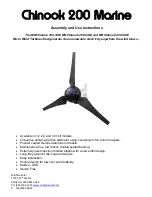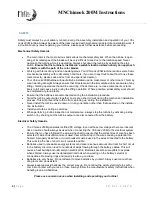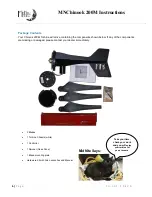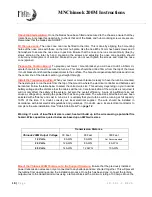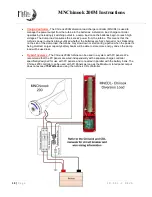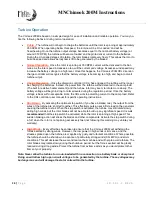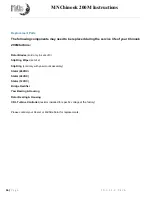
12 |
P a g e 1 0 - 3 3 1 - 2 R E V A
MNChinook 200M Instructions
Galvanic co
r
rosion of electrical joints -
Try to avoid connections between dissimilar metals. For
example, connecting copper and aluminum together will result in galvanic corrosion of the
connection. This will increase the electrical resistance of the connection (wasting energy by getting
HOT!), and reduce the mechanical integrity of the joint.
Protect the cables -
The power transmission wires must be protected from mechanical damage
and fatigue. Run the wires through an approved conduit.
Cable strain relief -
Prevent mechanical strain on the transmission wires running down from the
turbine. Clip the wires. Failure to do this will result in excessive mechanical strain on the wire joints
within the slip-ring assembly and may cause a failure. Wire ties or a Kellum type grip (see below)
are good ways to prevent mechanical strain on the cables.
Negative or Positive Ground System -
The
Chinook 200M
turbine output is isolated. This means
that there is no electrical connection between the output wires and the turbine chassis. In a
negative ground system, the negative terminal of the battery bank should be bonded to ground. In a
positive grounded system, the positive terminal of the battery bank should be bonded to ground.
This provides protection against the buildup of static and lightning strikes. The turbine mount
should be grounded separately with its own ground rod and an appropriate surge arrestor installed
to help prevent damage to the battery charging system during a lightning strike. Ensure that the
grounding cables are of the same rating as the positive and negative cables.
Wire Selection -
The wire size table shown on
page 10
should be used to select the minimum
Sized wire for a given transmission distance. Voltage drop in the wire will be reduced if a larger wire
is used.
Fuses -
The turbine and charging circuit should be protected with a suitably rated ‘slow-blow’ DC
fuse or DC circuit breaker. Please refer to the table below for the correct rating. The fuse or breaker
should be positioned between the turbine and batteries (on the positive wire). If a stop switch is
used (recommended) the fuse should be positioned between the switch and the batteries.
Important! Fuses and circuit breakers protect the wiring and prevent overheating and fire. Do not
use circuit breakers or fuses with a higher current rating than the wire it is protecting!
Chinook 200M Nominal Output Voltage
DC Fuse / DC Circuit Breaker Rating
12V
25 Amp
24V
15 Amp
48V
10 Amp
Run / Stop Switch -
The optional Midnite MNSTOPSWITCH is a simple brake switch that provides
a safe and easy way of stopping the turbine during high winds or for maintenance. As the switch is
thrown, the batteries are disconnected and the turbine is ‘shorted,’ reducing the rotor to a slow
rotation.

